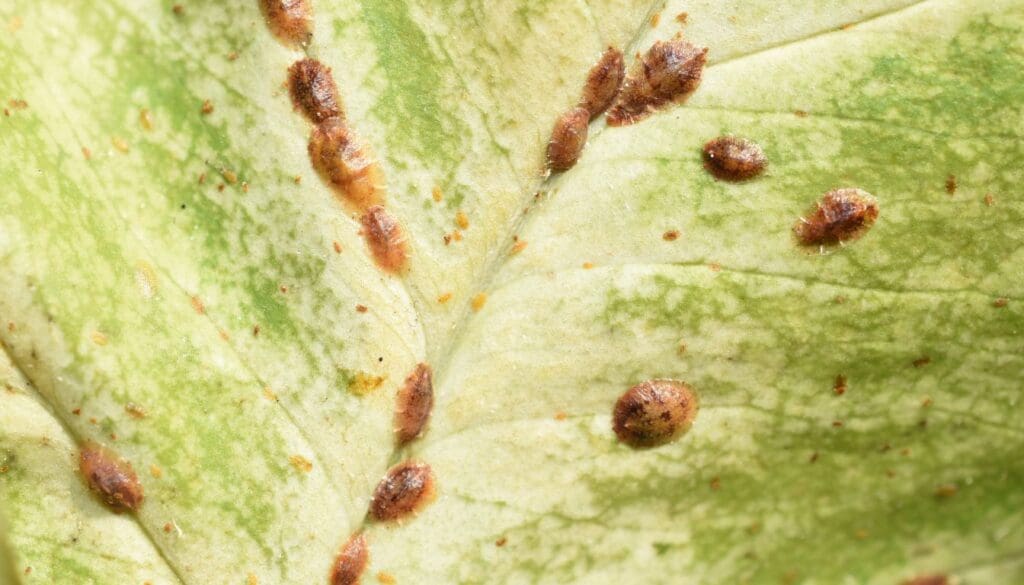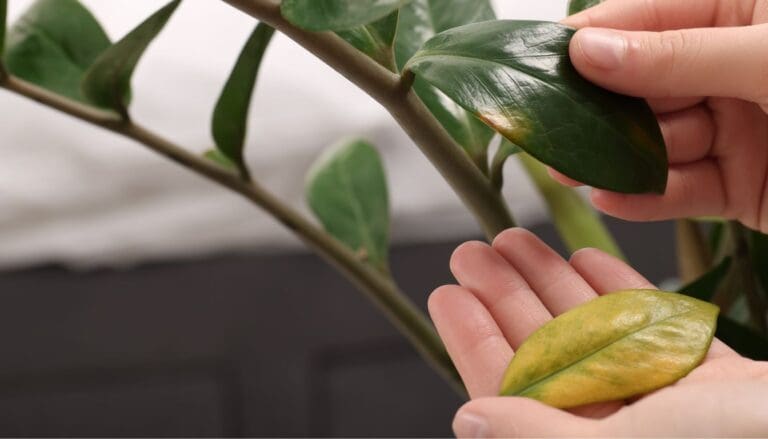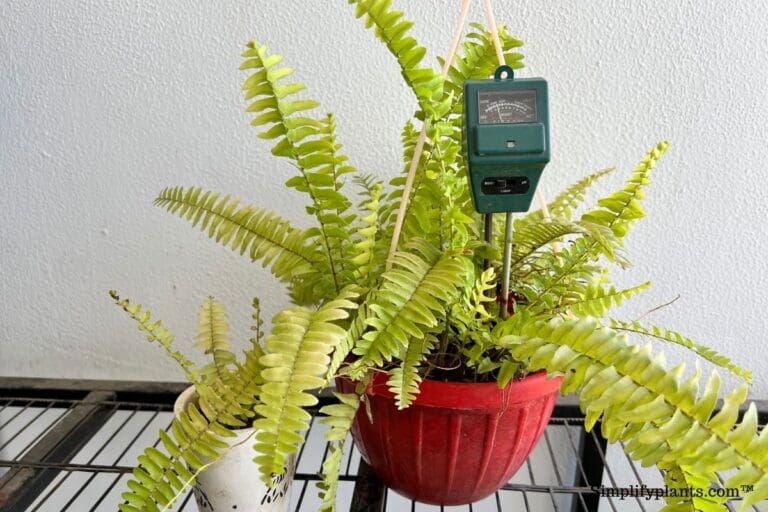7 Common rubber plant pests (+11 common diseases)
The Rubber plant, or Ficus Elastica, is loved for its hardy nature, low maintenance, and lush green leaves. But they can become susceptible to pests and diseases if conditions are made favorable.
The common Rubber plant pests are aphids, mealybugs, scales, whiteflies, and different mites. Diseases include leaf diseases, root diseases, powdery mildew, anthracnose, blights, crown gall, and Xanthomonas. Immediate action can stop spreading and save your plant.
We’ll cover all the common Rubber plant pests and diseases in this article. Read till the end to learn how to identify, treat, and prevent these issues for a healthy plant.

Please note: Simplify Plants is reader-supported. Some links in the post are affiliate links and I get a commission from purchases made through links in the post.
Common pests on the Rubber plants and Pest control
Pests are a nuisance for all the plants, and Rubber plants are no exception.
However, identifying these pests early can help you take measures to eliminate them and control their population.
Readers often email me asking about Rubber plant pests and how to deal with them.
After deep research, I discovered seven common pests and ways to eradicate them. Let’s have a look:
1. Aphids on Rubber plants

These bugs are tiny, soft-bodied insects that cluster mostly under the new leaves and buds and feed on the plant sap.
Check for small, pear-shaped bodies under the leaves, like green, black, red, pink, or brown. These cause the leaves to become yellow or brown, curly, and distorted.
I faced the issue last year and overcame it. Here’s what you can do:
- Isolate your plant and remove the badly infected leaves to avoid spreading.
- Shower the plant, mainly the underside of the leaves, to dislodge them.
- Make a homemade spray by adding 1 teaspoon of dish soap with 1-quarter of water and apply it to the affected areas, focusing under the leaves and near the bugs.
- Release predators like ladybugs, lacewings, and hoverflies. They will feed on the bugs and make the plant bug-free.
- Use insecticidal soap or neem oil to suffocate the bugs. Apply them every 7 to 10 days until the aphids are dead.
2. Mealybugs on Rubber plants

Mealybugs are small, white, and cottony-looking insects.
You can identify the infestation by fuzzy clusters or cotton-like substances under the leaves or along the stems.
These bugs excrete honeydew and encourage black sooty mold.
If you find any white substances, here are some solutions to eliminate mealybugs:
- Isolate your plant to avoid spreading to other houseplants.
- Spray neem oil for pest control.
- Dab a cotton swab in rubbing alcohol and wipe the infected areas to kill the bugs.
- Release ladybugs, parasitic wasps, and predatory beetles like Cryptolaemus montrouzieri to let them feed on the bugs.
- Use a systemic insecticide made for killing mealybugs. These insecticides get absorbed by plants and transported to various plant parts. As the bugs try sucking the sap, they consume the insecticide and die.
3. Red spider mites on Rubber plants
These arachnids are rarely visible to the naked eye.
They stay mainly under the leaves and create webs.
The common spider mites are the red and two-spotted spider mites.
They feed on the plant sap, making them yellow, brown, or curly.
You can identify their infestation by the webbings on the leaves and stems.
To combat these pests, here’s what you need to do:
- Quarantine the plant and remove the webbing with a hand or brush.
- Trim off the infected leaves.
- Mix one tablespoon of neem oil, 1 teaspoon of liquid dishwashing soap, and 1 quarter of water very well in a spray bottle and use it on the infected parts. It will suffocate the bugs and kill them. Repeat every few days.
- Introduce insects like predatory mites such as Phytoseiulus persimilis or Neoseiulus californicus.
- Use miticides for large infestations to control the mites. Follow the instructions to avoid overdose.
4. Scale pests on Rubber plants

Scales are small, oval-shaped insects that fasten themselves to the leaves and stems of the plant.
These bugs have a protective wax-like coating that protects them from pesticides and gives them a scale-like appearance.
These insects can be brown, black, or white. Heavy infestations can stress the plants and make them yellow or wilted.
To eliminate scales:
- Isolate and pick the scales with a hand or tweezers if visible.
- Soak a cotton swab with rubbing alcohol and wipe the infested leaves. Concentrate on the stems and under the leaves.
- Release predators like ladybugs and parasitic wasps to control the bugs.
- Apply horticultural oil or systemic oil. The horticultural oil will suffocate the pests and kill them. Systemic oil gets absorbed by the plant, and as the pests ingest the oil while sucking the sap, they die. Follow application, dosage, and dilution instructions on the product label.
5. Whiteflies

The tiny winged white flies are found on the underside of the leaves.
They suck the sap and leave behind honeydew.
Over time, the leaves turn yellow and wilted.
You will see them flying around in a cloud of tiny white insects when disturbed.
Try the following methods to eliminate them:
- First off, isolate the plant to prevent spreading.
- Mix 1 teaspoon of liquid dishwashing soap and 1-quarter of water and spray the solution on the infected areas, especially under the leaves. Do it every few days until the infestation stops.
- Use a systemic insecticide or a whitefly insecticide.
- Spray neem oil to eradicate the flies.
- Use sticky trap cards. As they fly, they get trapped in the card.
6. Yellow mites
Yellow mites, also called Lorryia Formosa, are Acariformes mite species.
I received a photo through email from one of my readers.
I saw several yellow dots on some leaves, yellowing, and defoliation.
If you see this, yellow mites have infested your plant.
To get rid of the yellow mites:
- Isolate your plant immediately to avoid spreading.
- Shower your plant to dislodge the pests from their place.
- Spray the plant with insecticidal soaps or horticultural oil.
- Use insecticidal sprays containing Malathion to kill the bugs.
- Release natural predators to kill the mites.
7. Scarlet mites
This mite is a flat, sedentary mite that lives in groups.
The mites feed on the undersurface of the leaves, mainly near the midrib and petiole.
You will find dark brown necrosis on the midrib and petioles.
Heavy infestation can cause defoliation.
To eliminate these mites:
- Quarantine your plant to avoid spreading to the other plants.
- Release natural predators like western predatory mites, brown or green lacewings, and ladybugs.
- Use neem oil or horticultural oil and spray them on the infected areas.
- Remove the infected leaves to avoid spreading.
- Use insecticides and pesticides containing pyrethrins to kill the mites.
14 Rubber plant diseases
While some diseases are curable, others are incurable and can wither your plant over time.
Therefore, identifying these diseases early is essential for effective treatment and fast recovery.
Below are some diseases that can attack your plant – both common and uncommon.
1. Leaf spot diseases

Leaf spot disease causes dark spots or lesions on the foliage.
Depending on the specific disease, these spots can be of different colors and sizes.
Some leaf spot diseases are Cercospora leaf spot, Colletotrichum leaf spot, and Phyllosticta leaf spot.
To treat the disease:
- Remove and destroy the infected leaves to avoid spreading.
- Make a homemade fungicide by mixing 1 part baking soda and 10 parts water. Spray it over the infected parts of the plant.
- Use a copper-based fungicide to control the leaf spot disease.
- Improve air circulation around the plant by pruning and avoiding overhead watering.
2. Other Rubber plant leaf diseases
- Phytophthora Leaf Fall Disease: Several fungi can cause the disease – Phytophthora meadii, Phytophthora Palmivora, and Phytophthora citricola. The disease spreads through splashed water, damp air, and insects. Avoid overhead watering and keep the leaves dry.
- Corynespora Leaf Fall Disease:
- The fungus is Corynespora cassiicola. It causes circular spots on the leaves with a brown or white papery center surrounded by dark reddish-brown rings. There is no treatment. To control the disease, burn the infected plants. If the infection is less, use some fungicides of Captan, Antracol, and Dithane M 45.
- Bird’s Eye Spot Disease: Caused by the fungus Bipolaris heveae, the disease occurs during hot weather and attacks young, weak, and exposed plants. Leaves develop dark brown water-soaked areas, while others turn black, shrivel, and distort. Control the disease by spraying Bordeaux mixture or any copper-based fungicide repeatedly at weekly intervals. Care for the seedlings by giving them adequate nutrition, well-drained soil, and correct watering.
3. Powdery mildew
Powdery mildew causes white or gray, powdery coating on the leaves and stems.
The problem arrives mainly during high humidity and prolonged wet conditions.
Over time, the disease can cause leaf distortion, stunted growth, and premature leaf drop.
To combat the disease:
- Isolate your plant to prevent the disease from spreading.
- Remove the badly infected leaves from the plant, especially the yellow leaves. They won’t turn green.
- Spray some neem oil on the infected leaves.
- Improve airflow to reduce spore spreading.
- Make a homemade fungicide by mixing 1 teaspoon of liquid dish soap with 1-quarter of water. Spray this on the affected leaves. Apply this every week until the disease is controlled.
- Avoid overhead watering. If the leaves are wet, pat them dry with a soft cloth.
4. Anthracnose
Anthracnose affects the leaves and stems of the Rubber trees.
You will notice dark, sunken lesions with concentric rings.
The infected leaves die and negatively impact the overall health and development of the plant.
When you see these signs, isolate your plant and remove the badly infected leaves to avoid spreading.
Apply some copper-based fungicides to prevent the disease from spreading and suppress it.
Improve air circulation around your plant by pruning and thinning out the branches. Avoid overhead watering.
5. White Root Disease

The disease is caused by the fungus Rigidoporus microporus.
The leaves lose their shine, color, and curvature.
The garden soil is the culprit as it might have infected root debris of old plants.
The fungus attacks the roots, and the disease spreads throughout your plant.
On the roots, the growing ends of the network of rhizomorphs become whitish.
The mature rhizomorphs become brown over time.
The severely infected roots are soft and mushy with a creamy color.
The leaves of immature plants become leathery and curve downwards.
The only way to fight this disease is to repot your Rubber plant.
If too many roots have decayed, destroy the plant.
To control the disease:
- Soil sulfur amendment is another indirect, biological method.
- Grow disease-resistant varieties.
- Improve the cultural practices.
6. Black Root Disease
The Ascomycete fungus, Xylaria thwaitesii, causes black Root disease of Hevea.
The first symptom of the disease is clusters of fructification from the lateral roots or at the collar of the Rubber plant.
The disease advances fan-wise in the lateral roots.
Over time, the mycelium aggregates into streaks, forming a continuous patchy, thin, smooth, and black skin on the root surface.
Here’s what you can do to control it:
- Remove the lateral roots affected by the fungus. You can recognize them by the lack of latex while slightly scraping the root surface.
- Use a collar protectant like Fomac 2 or Collar Protectant containing pentachloronitobenze as the active ingredient to the collar and basal parts of the laterals and on top of the taproot before you add soil while repotting.
- Apply the protectant as a prophylactic measure on the root system of the healthy plants.
- If maximum roots are damaged, burn the plant.
- Remove the diseased plant parts and keep the surroundings clean.
- Apply sulfur dust in a focused area to prevent the disease from spreading.
7. Root Rot disease
Root rot results from prolonged wet conditions caused by excess water or poor drainage.
Excessive moisture reduces oxygen, suffocates the plant, and hinders nutrient uptake, leading to yellowing, stunted growth, and defoliation.
Over time, the fungus starts attacking the roots.
The roots start decaying, and you get a bad smell whenever you are close to the plant.
The same occurs when you use a soil or pot with poor drainage.
Water can’t escape and stays stagnant.
To improve the condition, you need to repot your Rubber plant:
- Take out the plant and check the roots. If 50% of the roots have decayed, discard the plant; otherwise, there is a chance of survival.
- Remove the brown and mushy roots and keep the white roots.
- Remove maximum soil from around the roots and spray some fungicide.
- Take a new pot, 1-2 inches bigger than the old one.
- Make a new, well-drained, well-retained, and fertile soil mix. Whatever soil mix you use, ensure it contains peat moss for retention and perlite, vermiculite, or coarse sand for drainage.
- Fill up the new pot with a new soil mix, plant at the center, and cover the remaining base with the soil. Water the plant and place it under indirect sunlight.
- With proper care and maintenance, your plant will start healing.
Repotting should be done during active spring months; emergency repotting can be done anytime.
Make sure to provide proper moisture, sunlight, warm temperature, and high humidity post-repotting.
Fertilize a few weeks later once you see signs of recovery.
8. Fusarium Wilt
Caused by the fungi Fusarium solani, Fusarium wilt attacks the roots.
When infected, the plant will have browning at the barks.
Lesions rupture, releasing white latex as the disease progresses.
Under the bark, the phloem and xylem ridge and turn brown.
To control the disease, here are a few things you can do:
- Apply systemic fungicide.
- Avoid overwatering and wounding the roots.
- Raise the soil pH and use nitrate-based fertilizers.
- Avoid using any ammonium-based fertilizers.
- Keep the soil temperature to be cooler by using mulch.
- Grow disease-resistant varieties.
9. Southern Blight

The fungus Sclerotium rolfsii causes Southern Blight.
It occurs when the weather remains warm and moist.
Common symptoms are discolored lower leaves, wilted leaves, premature defoliation, and collapsed plants.
The reason is using garden soil in the soil recipe.
Controlling the disease can be challenging because fungicides are only available to commercial growers.
Try these instead:
- Remove the diseased plant from others and discard the soil.
- Avoid using garden soil. If you must use it, solarize or sanitize the soil.
- While solarizing, the top few inches of the soil should reach a temperature of 122°F.
- You can warm it up in a microwave at the exact temperature and use it.
10. Crown Gall in Rubber plants
This bacterial illness affects the Rubber plant, creating galls on the leaves and stems.
Bacteria enter your plant through open wounds.
Look for signs like yellowing, browning, and early leaf loss.
Unfortunately, you cannot cure the disease.
You have to discard the plant and destroy it.
The best way out is prevention:
- Scrutinize your Rubber plant before you buy them from the market.
- Avoid wounds near the ground.
- Don’t use garden soil.
11. Xanthomonas Leaf Spot in Rubber Plants
The disease is caused by bacterial pathogens entering through open wounds in your Rubber plant while pruning or repotting.
Your Rubber plant may have premature yellow or brown leaves, which ultimately fall off.
The disease cannot be cured, and there are no bactericides available.
To control it, avoid overhead watering and consider drip irrigation. Water at the base.
Rubber plant pest and disease prevention
Prevention is the best method since certain diseases are incurable, and others are transmitted through pests.
Now that you know what pests and diseases can attack your plant and the steps to treat the issue, let’s look at some preventive measures.
Maintain proper plant hygiene.
Keep the surroundings of your Rubber plant clean, especially after pruning.
Clean the leaves regularly once a week to remove dust, debris, and pest eggs.
Remove the dead and damaged leaves occasionally to prevent the spreading of pests or diseases.
Provide correct growing conditions.

Use well-drained soil, and let the Rubber plants receive 6-8 hours of bright indirect sunlight.
Protect them from cold drafts, and maintain 50-60% humidity levels.
Fertilize the plant every 2-4 weeks during the growing season with a balanced liquid fertilizer.
Stop it in the winter.
Monitor your Rubber plant regularly.
Observe your plant daily for signs of infestation, like yellowing, browning, stunted growth, defoliation, distortions, or abnormal growth patterns.
Early identification and intervention to prevent the problem from spreading can keep your plant healthy and alive.
Concentrate under the leaves and stems.
Implement natural controls first and then chemical methods
For treatment, begin with natural controls like releasing ladybugs, lacewings, and predatory mites.
Also, releases natural predators or parasites, especially for targeting certain pests.
For diseases, use homemade fungicides like a mixture of baking soda and water in a ratio of 1:10.
If these don’t work, then approach for chemical treatments.
Ensure good air circulation.
Adequate air circulation around your plant can help prevent many diseases by dismissing the spores and reducing the buildup of extra humidity.
Consider light pruning regularly and space out the plants if there are many.
Practice the proper watering techniques

Rubber plant soil should be evenly moist, neither dry nor wet.
Allow the top few inches of the soil to dry out before each watering.
Always water the plant at the base, avoiding the leaves and overhead watering.
If the leaves are wet, pat them dry with a soft cloth.
Final thoughts
Inspect your plant daily to identify signs of pests and diseases. Look for specific symptoms displayed by the plant to address issues promptly. Prevention is the best way to prevent infestations or fungal and viral diseases.
Maintain proper hygiene, provide the right growing conditions, practice proper watering, ensure good airflow, and monitor the plant daily. Try using natural treatment methods like releasing natural predators, spraying neem oil, or using homemade fungicide by mixing baking soda and water.
If they don’t work, approach the systemic and chemical treatment methods. You can spray neem oil every 15 days to keep pests and diseases at bay. Do it in the evening.
How often should I inspect the Rubber plant for infestation signs?
Checking daily may not be possible for busy people, but try inspecting your plant thoroughly once a week. Concentrate on the stems and underside of the leaves.
Can I mist my plants with neem oil?
If you mist your plants regularly to adjust humidity, add some neem oil with water and spray it on the Rubber plants. Along with humidity, the mixture can keep pests and diseases at bay. Do it every 15 days.
Reference: Ficus Elastica Wikipedia
Recommended Garden Supplies
| Product Image | Our Recommended Gardening Supplies | Check Offers! |
|---|---|---|
Top Top
Top
Top
Top
Top
Top
Top
Top | rePotme Houseplant and Tropical Classic Potting Soil Mix | Check Offer On Amazon |
 Top
Top
Top
Top
Top
Top
Top
Top | Espoma Organic Indoor Plant Food | Check Offer On Amazon |
 Top
Top
Top
Top
Top
Top
Top
Top | GooingTop LED Grow Light 6000K Full Spectrum Clip Plant Growing Lamp | Check Offer On Amazon |
 Top
Top
Top
Top
Top
Top
Top
Top | Soil Moisture Meter | Check Offer On Amazon |
 Top
Top
Top
Top
Top
Top
Top
Top | Govee Hygrometer Thermometer, Bluetooth Enabled! | Check Offer On Amazon |
 Top
Top | LEVOIT Humidifiers for Large Room(Best For Plants) | Check Offer On Amazon |
 Top
Top
Top
Top
Top
Top
Top
Top | Upgraded DIY Automatic Drip Irrigation Kit, 15 Potted Houseplants Support | Check Offer On Amazon |
 Top
Top
Top
Top
Top
Top
Top
Top | Stainless Steel Heavy Duty Gardening Tool Set | Check Offer On Amazon |
 Top
Top
Top
Top
Top
Top
Top
Top | Bonide Insecticidal Soap | Check Offer On Amazon |
 Top
Top
Top
Top
Top
Top
Top
Top | Bonide 32 oz Spray Neem Oil for Organic Gardening | Check Offer On Amazon |
 Top
Top
Top
Top
Top
Top
Top
Top | Garden Safe Fungicide | Check Offer On Amazon |






